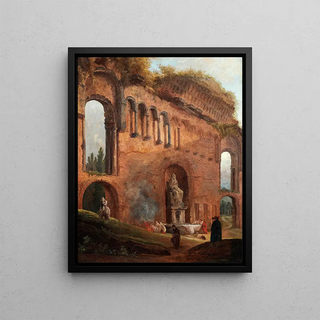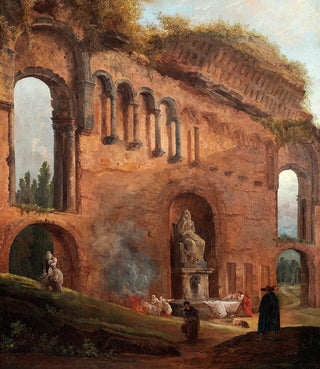Art print | Roman Ruins with Laundresses - Hubert Robert


View from behind

Frame (optional)
In a world where the past and the present meet, the artwork "Roman Ruins with Laundresses" by Hubert Robert stands as a poignant testament to the fleeting beauty of nature and humanity. This painting, evoking memories of ancient Rome, transports the viewer to a universe where the remnants of past civilizations blend with the daily life of laundresses. The eye lingers on the majestic ruins, while one can almost hear the whisper of water and the laughter of women at work. This serene scene invites deep contemplation, revealing the subtleties of a bygone era while celebrating the life that continues to weave itself into it.
Style and uniqueness of the artwork
Hubert Robert, often nicknamed the "painter of ruins," excels in depicting landscapes where the sublime meets the mundane. In "Roman Ruins with Laundresses," he manages to capture a soft, golden light that bathes the scene in an almost timeless atmosphere. The meticulous details of the ruins, with their stones worn by time, contrast with the freshness of the laundresses, whose white dresses seem to vibrate under the sun. The composition of the piece, skillfully orchestrated, creates a harmonious balance between architectural elements and human figures. Robert plays cleverly with shadows and lights, adding an almost poetic dimension to the whole. Each brushstroke tells a story, each shade of color evokes an emotion, making this piece not only a painting but a true invitation to travel through time.
The artist and his influence
Hubert Robert, born in 1733, made a notable place for himself in the artistic landscape of the 18th century. His fascination with ancient ruins, inherited from his travels in Italy, allowed him to develop a unique style, blending romanticism and realism. Robert does not merely reproduce scenes; he interprets, embellishes, and transforms them into true visual poems. His influence extends beyond his era, inspiring generations of artists, particularly those in the [rest of the text is cut off].

Matte finish

View from behind

Frame (optional)
In a world where the past and the present meet, the artwork "Roman Ruins with Laundresses" by Hubert Robert stands as a poignant testament to the fleeting beauty of nature and humanity. This painting, evoking memories of ancient Rome, transports the viewer to a universe where the remnants of past civilizations blend with the daily life of laundresses. The eye lingers on the majestic ruins, while one can almost hear the whisper of water and the laughter of women at work. This serene scene invites deep contemplation, revealing the subtleties of a bygone era while celebrating the life that continues to weave itself into it.
Style and uniqueness of the artwork
Hubert Robert, often nicknamed the "painter of ruins," excels in depicting landscapes where the sublime meets the mundane. In "Roman Ruins with Laundresses," he manages to capture a soft, golden light that bathes the scene in an almost timeless atmosphere. The meticulous details of the ruins, with their stones worn by time, contrast with the freshness of the laundresses, whose white dresses seem to vibrate under the sun. The composition of the piece, skillfully orchestrated, creates a harmonious balance between architectural elements and human figures. Robert plays cleverly with shadows and lights, adding an almost poetic dimension to the whole. Each brushstroke tells a story, each shade of color evokes an emotion, making this piece not only a painting but a true invitation to travel through time.
The artist and his influence
Hubert Robert, born in 1733, made a notable place for himself in the artistic landscape of the 18th century. His fascination with ancient ruins, inherited from his travels in Italy, allowed him to develop a unique style, blending romanticism and realism. Robert does not merely reproduce scenes; he interprets, embellishes, and transforms them into true visual poems. His influence extends beyond his era, inspiring generations of artists, particularly those in the [rest of the text is cut off].






